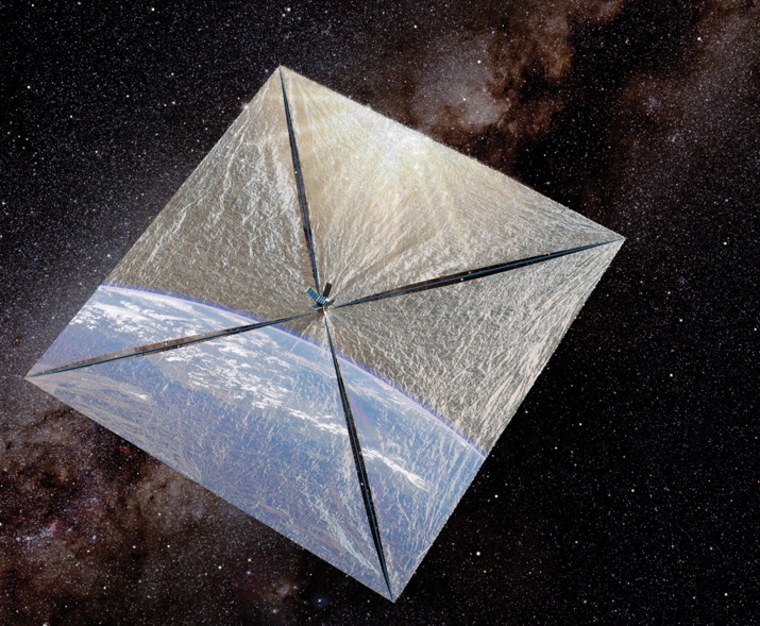Four years after its first solar sail ended up in the ocean instead of orbit, the Planetary Society announced Monday that by the end of 2010 it will try again to launch a spacecraft that will be propelled by the subtle pressure of sunlight.
LightSail-1 is envisioned as the first of a trio of solar sail craft in a project boosted by an anonymous $1 million donation, according to the space advocacy organization co-founded by the late astronomer Carl Sagan.
Solar sails are theorized as a way to achieve long-duration interstellar flight.
A solar sail would be propelled by the pressure of light — photons pushing against a surface — not the stream of ionized gas known as the solar wind.
The spacecraft would accelerate very slowly but eventually reach tremendous speeds because of the constant pressure.
"It's a low acceleration but it's continuous, whereas a rocket is a high acceleration but it ends quickly," Louis D. Friedman, the society's executive director, said in a telephone interview from Washington. "Eventually you'll have these missions lasting many years, reaching speeds approaching 100,000 mph, getting out of the solar system in five years instead of 25 years."
The Planetary Society's first solar sail, Cosmos 1, never reached orbit. It was launched in 2005 aboard a Volna rocket — a converted ballistic missile fired from a Russian submarine beneath the Barents Sea. The launch vehicle failed and fell into the ocean.
The new project will be based on a microsatellite technology known as CubeSat that was developed to give universities access to space.
LightSail-1 will be built around three CubeSat modules, each measuring about 4 inches (10 centimeters) on a side and weighing 11 pounds (5 kilograms) in all. Together, the modules will be "bigger than a toaster, smaller than a breadbox," Friedman said.
The spacecraft will launch with its four triangular Mylar sails packaged in a volume equal to about three quarts and unfurl to an area of more than 340 square feet (31 square meters), resembling a giant diamond-shaped kite.
Slideshow 12 photos
Month in Space: January 2014
It will orbit at an altitude of nearly 500 miles (800 kilometers) and operate for just a few days to determine if it can be controlled and to measure the orbital acceleration, Friedman said.
The mission cost will be about $1.8 million, and all funds will come from private sources, he said.
LightSail-1 will be built by Stellar Exploration Inc. of San Luis Obispo, Calif.
Friedman said the launch vehicle has not been chosen yet. Because of its small size, the spacecraft can "piggyback" on another mission's rocket as long as it is going to the right orbit, Friedman said.
The LightSail-2 spacecraft is planned for higher altitude orbits, and LightSail-3 is intended to be sent farther into space. Both missions will be planned to last much longer than the first.
The Planetary Society was not deterred by its previous failure and has not bitten off more than it can chew, Friedman said.
"There's always a little bit of arrogance in anybody building a spacecraft," he said. "These things are counterintuitive in so many ways, but you believe you can do it and when we succeed it's incredibly rewarding."
The society was founded in 1980 by Sagan; former Jet Propulsion Laboratory director Bruce Murray; and Friedman, a veteran of deep-space mission planning at JPL.
The Planetary Society has about the LightSail project.

